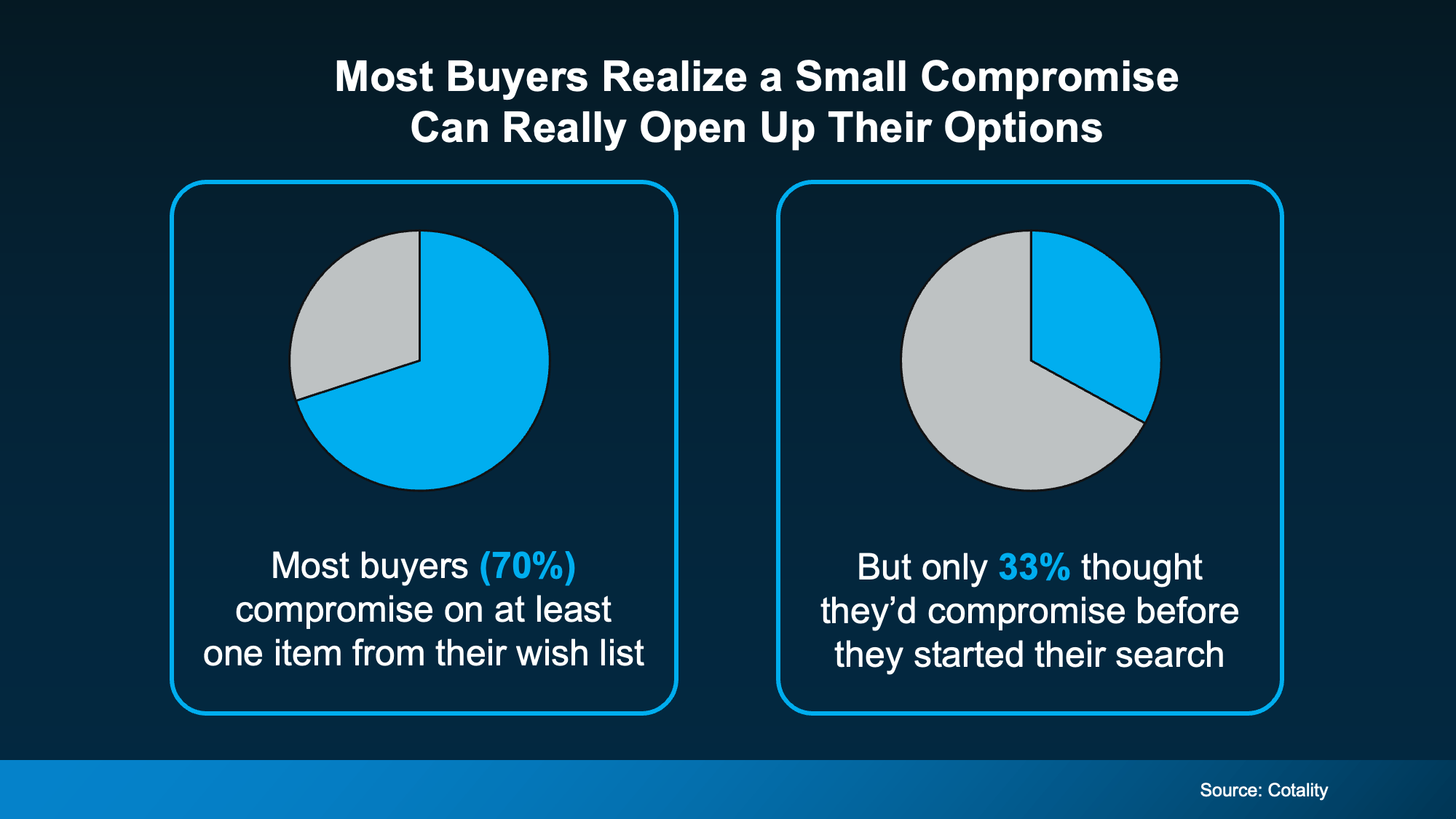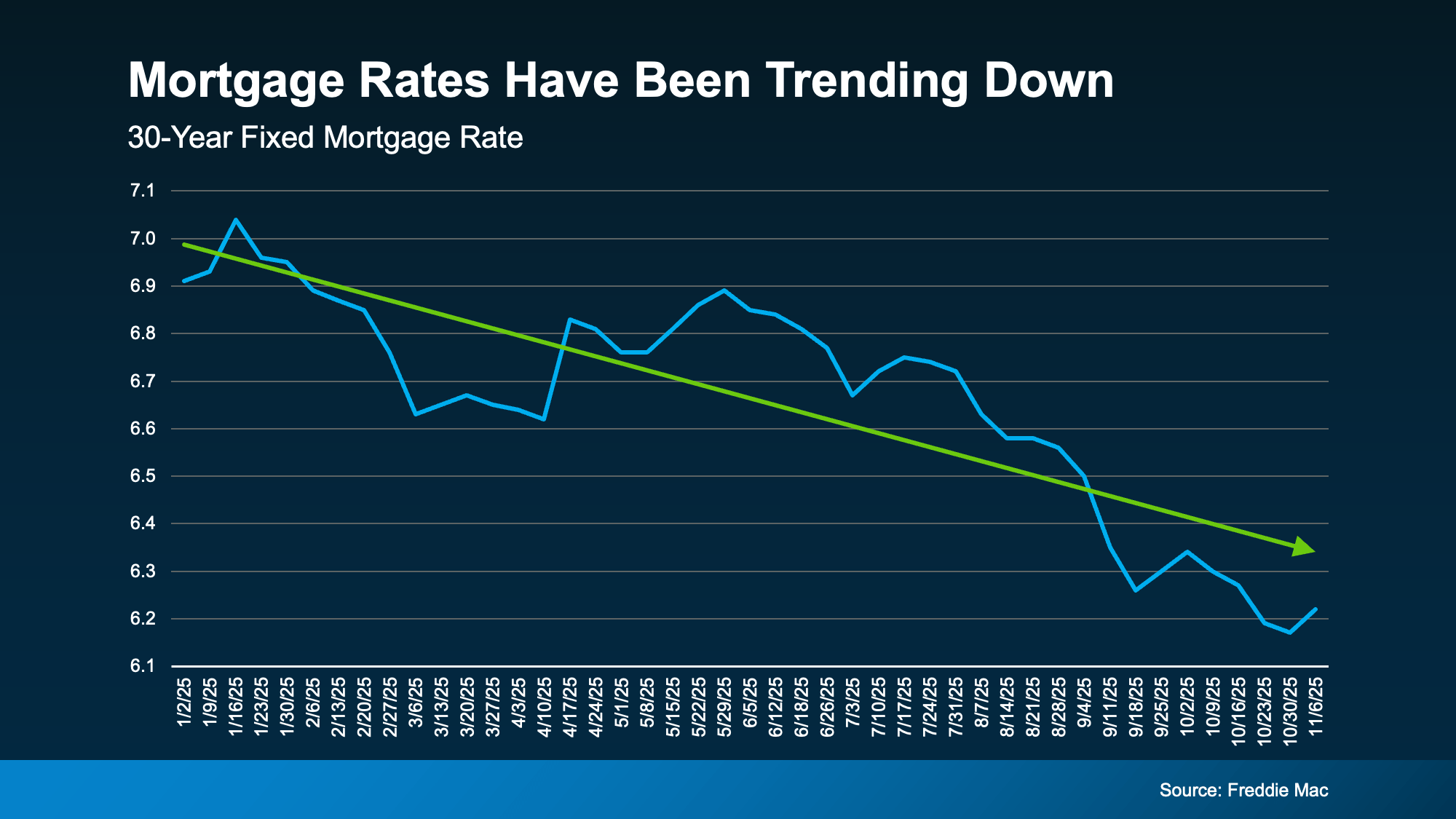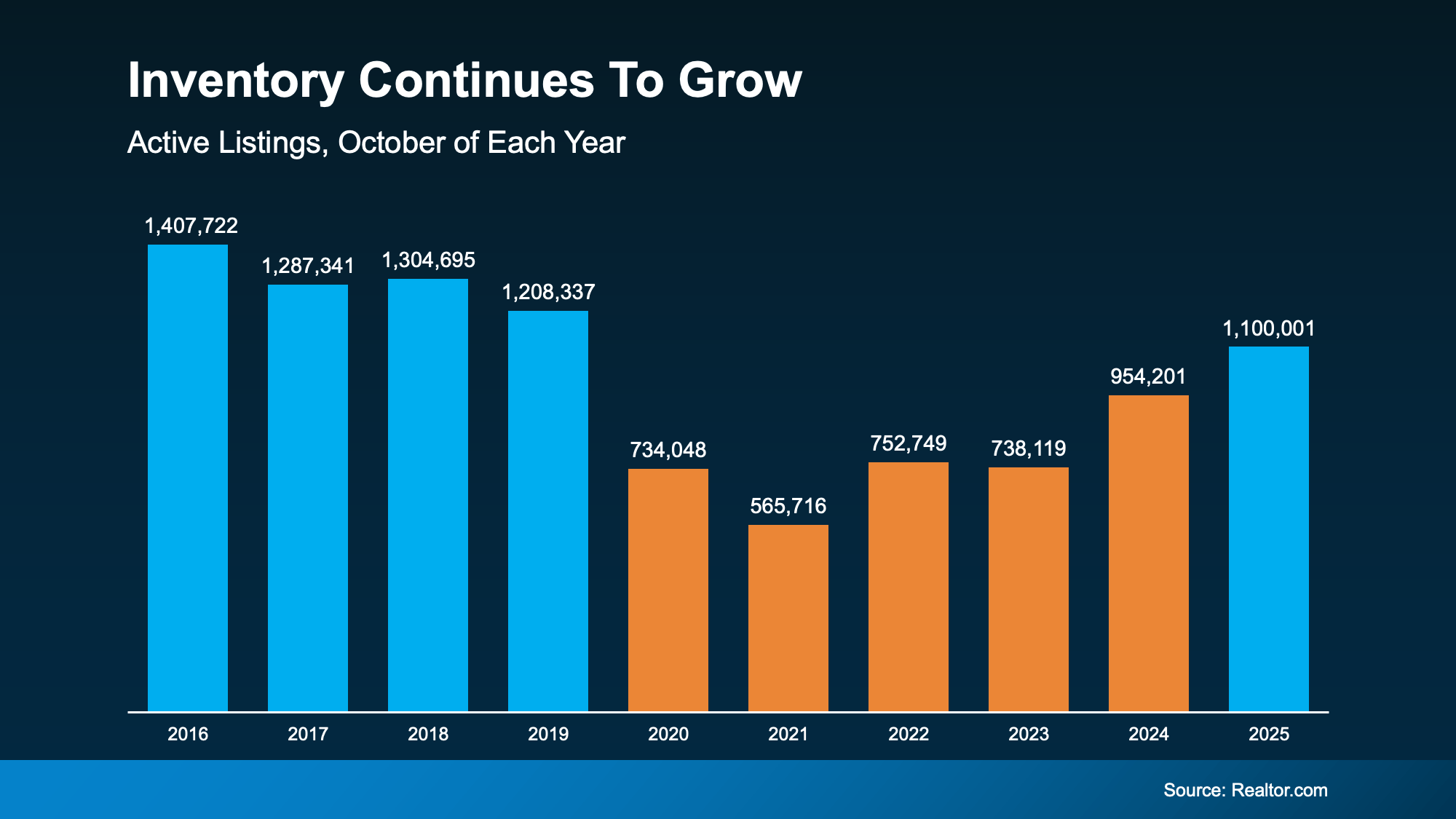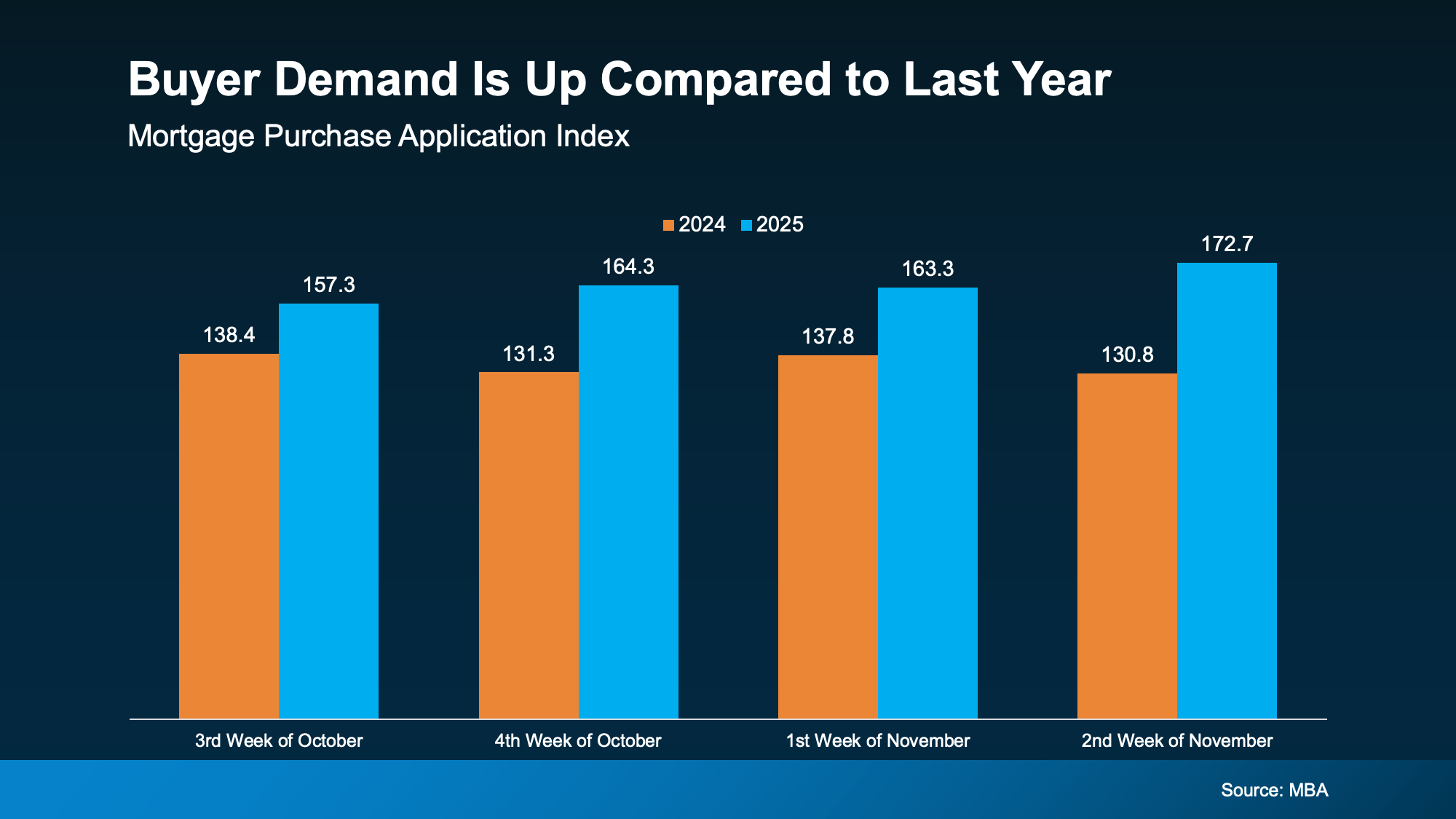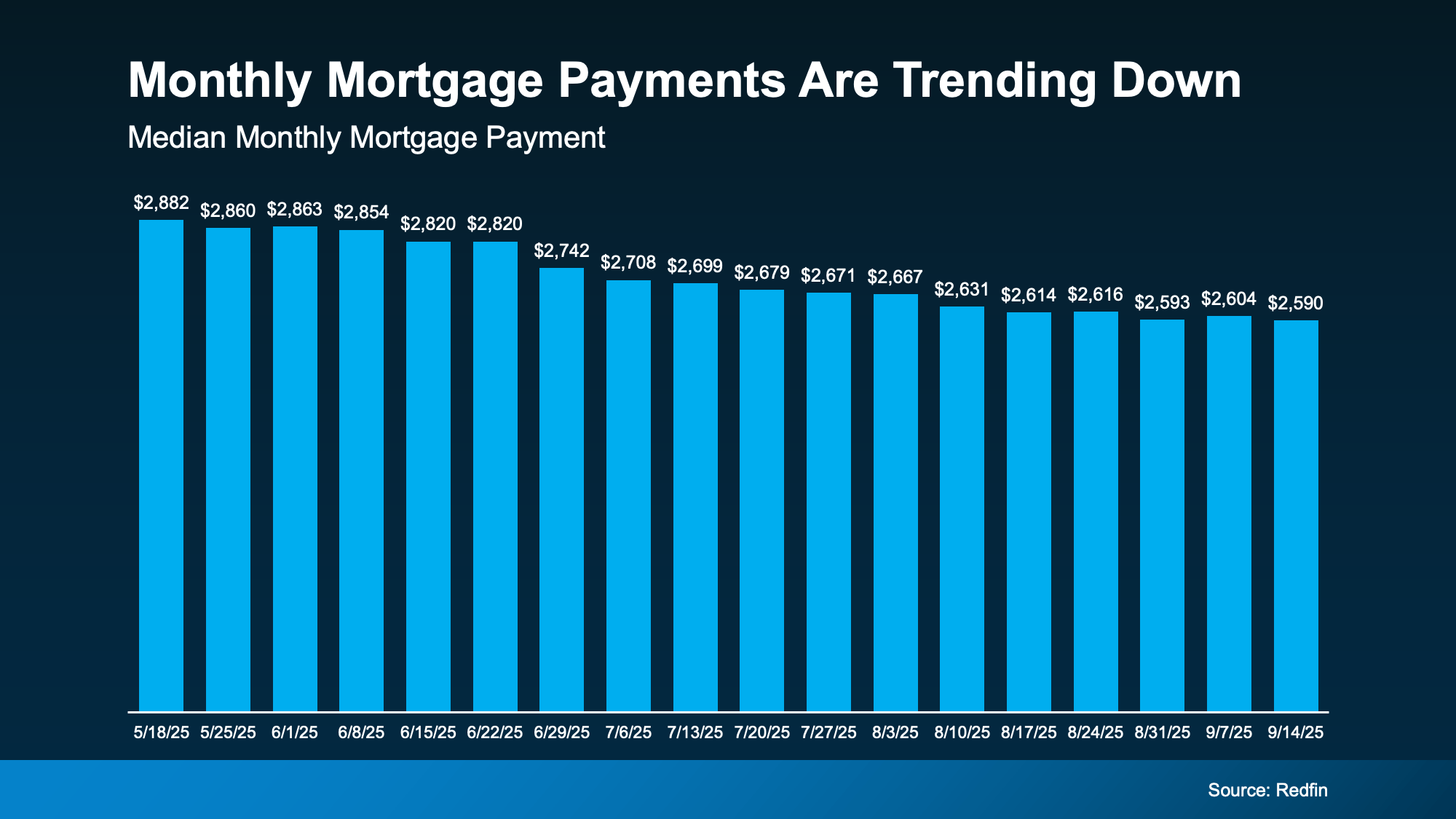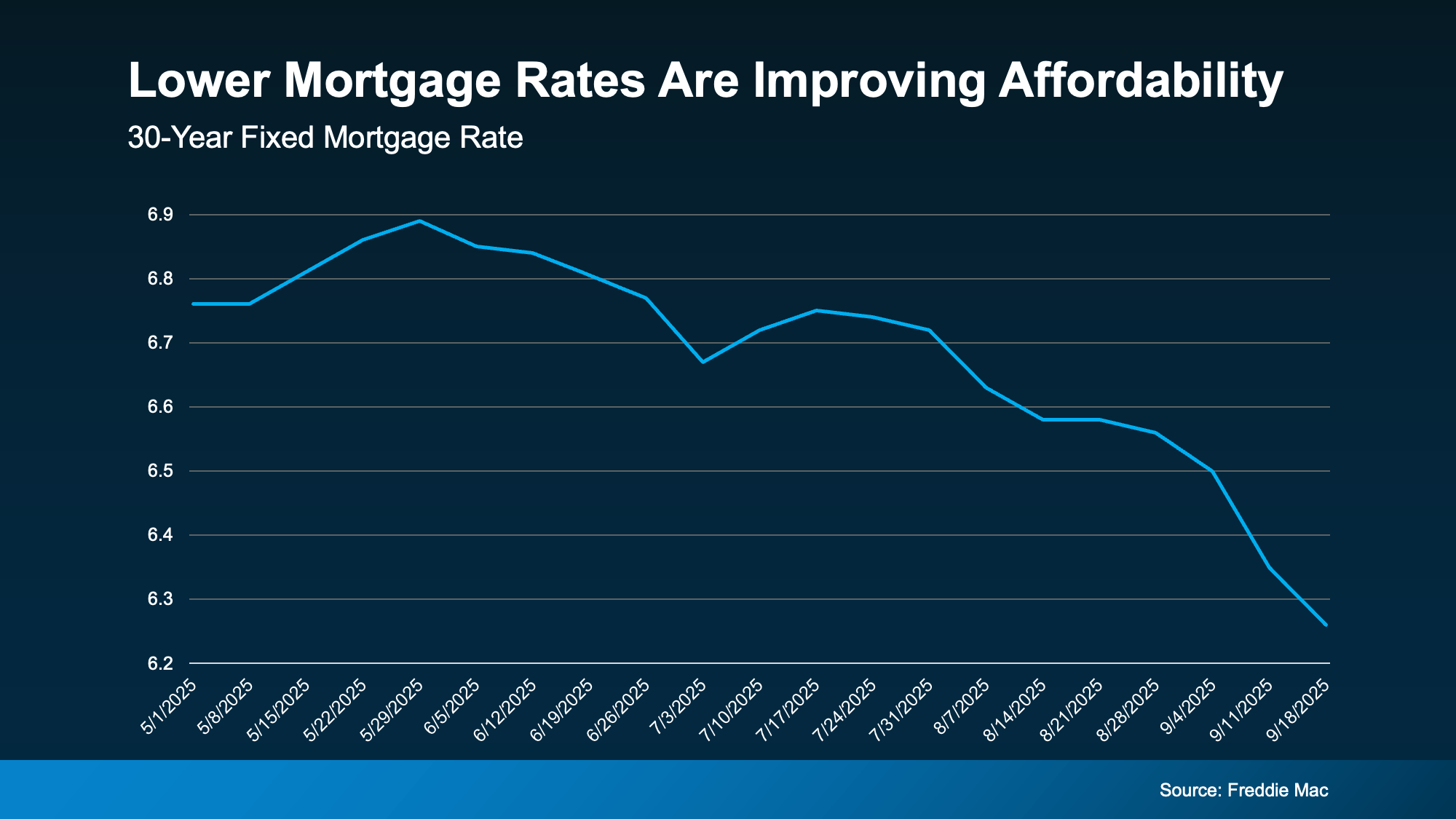Why More Homeowners Are Giving Up Their Low Mortgage Rate (And Why That Might Be Smarter Than It Sounds)

Why More Homeowners Are Giving Up Their Low Mortgage Rate
If you’re like a lot of homeowners, you’ve probably thought: “I’d like to move… but I don’t want to give up my 3% rate.” That’s fair. That rate has been one of your best financial wins – and it can be hard to let go. But here’s what you need to remember...
A great rate won’t make up for a home that no longer works for you. Life changes, and sometimes, your home needs to change with it. And you’re not the only one making that choice.
The Lock-In Effect Is Starting To Ease
Many homeowners have been frozen in place by something the experts call the lock-in effect. That's when you won't move because you don’t want to take on a higher rate on your next home loan. But data from Federal Housing Finance Agency (FHFA) shows the lock-in effect is slowly starting to ease for some people.
The share of homeowners with a mortgage rate below 3% (the yellow in the graph below) is slowly declining as more people move. And while some of the people with a rate over 6% are first-time buyers, the number of homeowners with a rate above 6% (the blue) is rising as others take on higher rates for their next home:
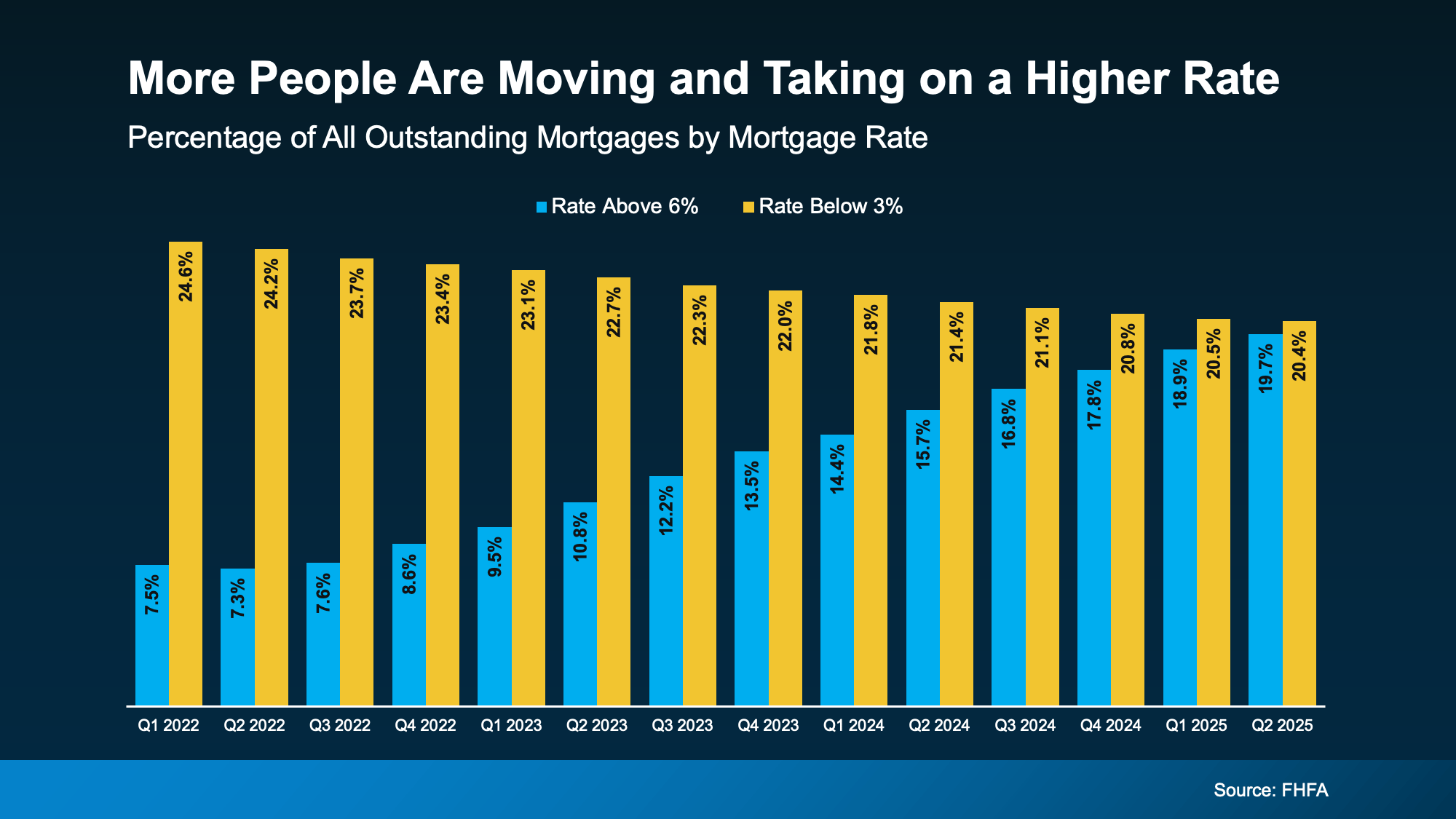
And while it may not seem that dramatic, it’s actually a pretty noteworthy shift. The share of mortgages with a rate above 6% just hit a 10-year high (see graph below). That shows more people are getting used to today’s rates as the new normal.
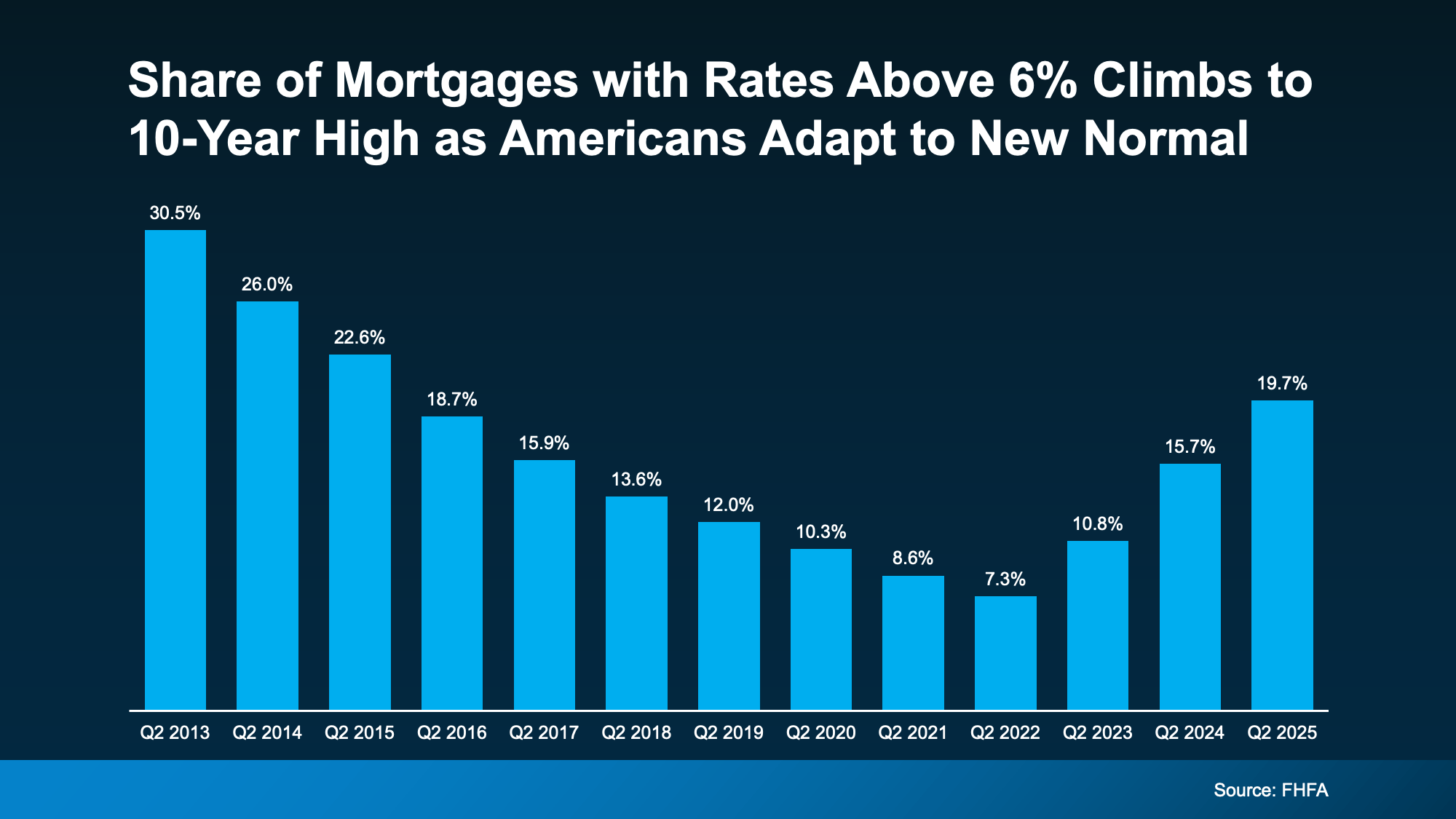
Why Are More People Moving Now, if It Means Taking on a Higher Rate?
It’s simple. Sometimes they can’t put their life on pause anymore. Families grow, jobs change, priorities shift, and a house that once fit perfectly may not fit at all anymore – no matter how good their rate was. And that’s okay. As Chen Zhao, Head of Economic Research at Redfin, explains:
“More homeowners are deciding it’s worth moving even if it means giving up a lower mortgage rate. Life doesn’t standstill—people get new jobs, grow their families, downsize after retirement, or simply want to live in a different neighborhood. Those needs are starting to outweigh the financial benefit of clinging to a rock-bottom mortgage rate.”
First American refers to these life motivators as the 5 Ds:
- Diplomas: People with college degrees typically earn more, and that adds up to more buying power. Maybe you bought your house when you were younger and now that you’ve graduated and have a rising career, you’re ready to move up.
- Diapers: You’ve outgrown your space. If you’re welcoming a new baby, your current home might not be cutting it anymore.
- Divorce: Whether it’s ending a marriage (or starting one), it can create the need for a new place to call home.
- Downsizing: You’re ready to downsize. Maybe the kids have moved out and it’s time to simplify. Smaller house, less maintenance, more freedom.
- Death: If you’ve recently lost a loved one, maybe you’ve realized you want to be closer to family. Life’s too short to live far from the people who matter most.
Whatever your reason, here’s what you need to think about. Yes, your low rate is great. But staying put means your life may stay on hold. And maybe that’s not working for you anymore.
According to Realtor.com, nearly 2 in 3 potential sellers have already been thinking about moving for over a year. That’s a long time to press pause on your plans. On your needs. On your family’s goals. So, maybe the question isn’t: “Should I move?”
It’s actually: “How much longer am I willing to stay somewhere that no longer fits my life?”
Because we’ve already seen rates come down from their peak earlier this year. And they're expected to ease a bit more in 2026. When you stack that on top of the very real reasons you may need a new home, it may be enough to finally move the needle for you.
Bottom Line
Life doesn’t wait for the perfect rate. Maybe you shouldn’t either.
With mortgage rates down from their peak and forecast to dip slightly more in 2026, moving may be more feasible than you think. If you’re ready to see what’s possible in our market, let’s talk.
Is Winter a Good Time to Sell Your Home in Massachusetts? (The Truth May Surprise You)

Is Winter a Good Time to Sell Your Home in Massachusetts? (The Truth May Surprise You)
If you’ve ever heard that “nobody buys homes in winter,” I’m here to tell you that’s a myth, especially in Massachusetts.
Sure, buyers might be wearing gloves and boots, and yes, your landscaping is probably taking a long nap under a snowbank. But here’s the twist: winter can be one of the most strategic times to sell your home.
Especially in towns like Walpole, West Roxbury, Roslindale, Dedham, Norfolk, Wrentham, and Westwood where inventory is already tight.
Let’s walk through the real data, the real pros and cons, and what sellers can do to win the winter market.
What the Massachusetts Market Looks Like in Winter
Even though buyer activity dips, the market does NOT shut down.
Low Inventory = Big Advantage for Sellers
Data from Lamacchia Realty and MLS-PIN indicates:
- Winter months show the lowest inventory of the year,
- Massachusetts inventory often dips to 1.5–2 months of supply in January/February,
- Buyers who are active during winter tend to be serious and ready to close.
Less competition can mean your home:
✔ gets more attention
✔ stands out more
✔ may receive stronger offers
✔ spends fewer days on market
Sales Still Happen AND Prices Stay Strong
Look at January 2025:
- Home sales were up over 7% year-over-year in Middlesex, Norfolk, and Suffolk County
- Average sale price in those counties jumped 9.3%
Even in the coldest part of the year, homes are moving… and moving well.
Why Selling in Winter Can Actually Work In Your Favor
1. You Face Less Competition
Spring brings a flood of new listings. Winter brings… not much.
That scarcity works in your favor.
A buyer touring four homes instead of twenty is going to remember yours.
2. Winter Buyers Are Highly Motivated
People shopping for homes in winter are almost never “casual browsers.”
They are often:
- Job relocators
- Growing families who can’t wait
- Renters whose leases are expiring
- Buyers tired of spring bidding wars
These buyers come prepared, pre-approved, and ready to submit offers.
3. Your Home Can Feel Extra Warm & Inviting
Winter staging is underrated.
Soft lighting, warm colors, a cozy living room creates an environment where buyers feel the emotional pull instantly.
If you’ve ever been in a house in January with the fireplace going… you get it.
4. Faster, More Efficient Closings
Winter typically means:
- Fewer transactions overall
- Lenders and attorneys with lighter caseloads
- Faster appraisal and inspection schedules
This leads to a quicker path from offer → closing.
Challenges Sellers Need to Navigate
1. Exterior Curb Appeal Is… Icy
Snow and dormant landscaping don’t do your yard any favors.
Buyers can’t:
- See the lawn
- Assess the garden
- Inspect the full roof
- Visualize summer curb appeal
But you can work around this. (Scroll to the staging checklist below.)
2. Fewer Buyers Touring
You will likely have fewer total showings.
But each showing is likely more serious. A benefit in disguise.
3. Weather Can Interfere with Showings
Storm delays, rescheduling, early sunsets… all part of the Massachusetts winter lifestyle.
Sellers should have:
- Multiple showing-time options
- Night-time lighting ready
- Clear sidewalks and de-iced driveways
- A flexible schedule
Seller Checklist: How to Sell Successfully in Winter
Exterior Prep
✔ Shovel walkways, steps, driveways before every showing
✔ Add exterior lighting. Those sunsets are early!
✔ Place a new doormat (buyers notice!)
✔ Salt walkways for safety
Interior Prep
✔ Keep the heat comfortable (nothing says “run” like a cold house!)
✔ Add warm throw blankets, soft lighting, candles (unscented)
✔ Use bright bulbs to counter the darker days
✔ Remove bulky winter coats/shoes from the entryway
✔ Clean windows. Winter sunlight shows everything
Marketing Prep
✔ Use professional photography (That’s a non-negotiable. I ALWAYS do!)
✔ Include summer exterior photos in your listing. If you have photos let’s show off the landscaping
✔ Highlight heating system age, insulation, windows
✔ Promote energy-efficiency upgrades (huge in Massachusetts)
Local Insights: How Winter Selling Performs in Your Towns
Walpole, Norfolk, Wrentham, Westwood
These suburbs typically see:
- Strong buyer demand year-round
- Low winter inventory
- Commuter-rail appeal even in winter
- Families relocating for school districts
Your listing stands out more.
West Roxbury, Roslindale, Dedham
Winter attracts:
- First-time buyers
- Downtown city-to-more suburban movers
- Renters looking to leave their leases
These buyers tend to be decisive and ready to move fast.
So... Should You Sell Your Home This Winter?
If your timeline allows it, then yes, winter can be a powerful time to sell in Massachusetts.
You’ll face:
- Less competition
- Motivated buyers
- Potentially quicker closings
With the right preparation, your home can absolutely shine in a winter market.
Thinking about selling this winter? Get your free Winter Home Value Estimate and custom Winter Seller Strategy today.
What a Government Shutdown Really Means for the Housing Market (and Why It’s Not the Disaster You Think)

What a Government Shutdown Really Means for the Housing Market (and Why It’s Not the Disaster You Think)
The Big Question on Everyone’s Mind
There’s been a lot of talk lately about how a government shutdown might affect the housing market. If you’ve scrolled through the news or social media lately, you’ve probably seen headlines suggesting chaos and confusion. You might even be wondering if home sales grind to a halt when Washington does.
The short answer? Nope.
While a shutdown can cause a few speed bumps, it doesn’t stop the real estate market. Homes are still being bought and sold, contracts are still being signed, and closings are still happening. The difference is that a few parts of the process may slow down—but overall, the market keeps moving.
What Typically Happens When the Government Shuts Down
Whenever the federal government shuts down, certain agencies temporarily close or scale back operations. And since real estate has a few moving parts that depend on those agencies, some transactions experience small delays.
Here’s how it usually plays out:
-
Loan Processing Delays:
Buyers using FHA, VA, or USDA loans may experience delays in getting their loans processed. These types of loans make up roughly a quarter of all mortgage applications, and when agency staff are furloughed, approvals can take longer.“Applicants for FHA, VA, or USDA loans—which account for about one-quarter of all mortgage applications—may encounter significant processing delays due to agency furloughs.”
– Selma Hepp, Chief Economist at CoreLogic -
Flood Insurance Snags:
If you’re buying in a flood zone, federal flood insurance may be required to close. The National Flood Insurance Program (NFIP) sometimes pauses during shutdowns, which can temporarily stall closings until the government reopens. -
Verification Backlogs:
Lenders often rely on IRS and Social Security verification systems to confirm income or identity information. During a shutdown, those systems can slow or temporarily close, which creates a minor backlog in mortgage underwriting.
Even with those hiccups, most deals still move forward. Real estate agents, lenders, and attorneys have become experts at navigating these pauses. If a buyer’s loan requires a federal verification, for example, many lenders can proceed “subject to” confirmation once the system is back online.
The Housing Market Doesn’t Stop—It Just Slows Down Briefly
The important thing to understand is that the housing market doesn’t freeze—it flexes.
If you look back at the last major government shutdown, which lasted 35 days from December 22, 2018, to January 25, 2019, you’ll see what really happens.
According to the National Association of Realtors (NAR), home sales dipped slightly during the closure—but rebounded quickly once the government reopened.
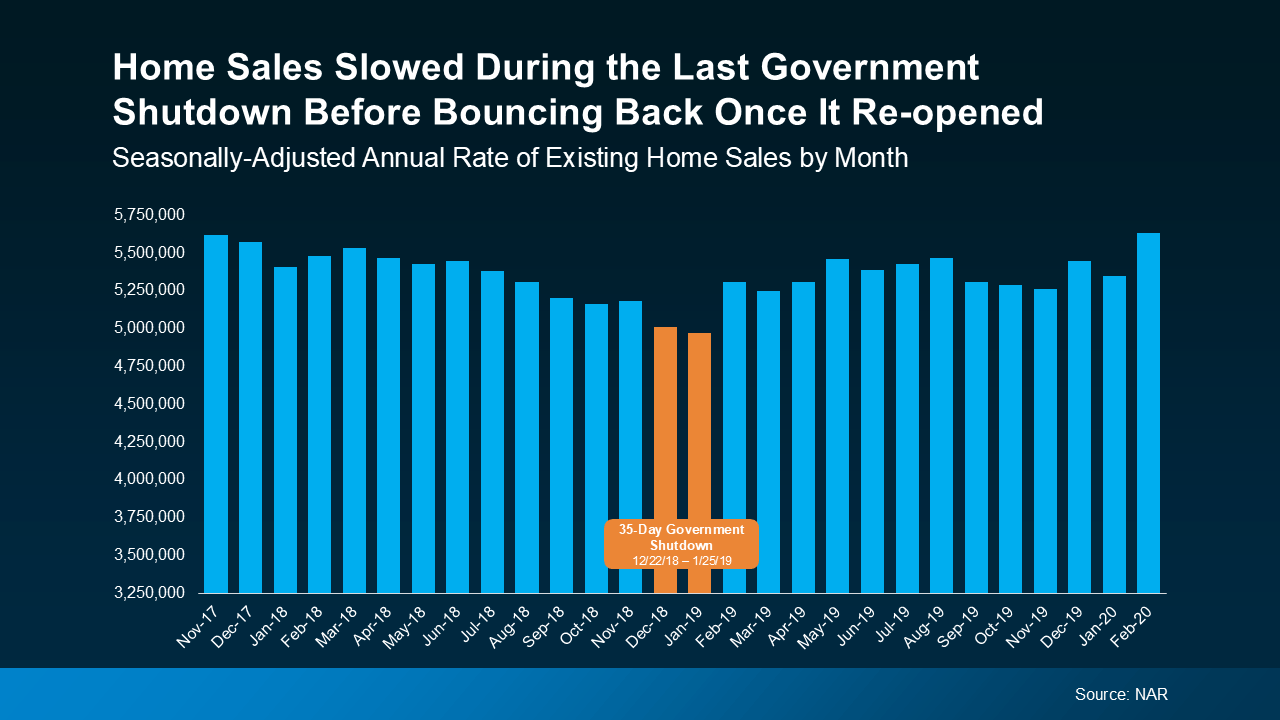
The data shows a short-term slowdown during the shutdown (the orange bars), followed by a strong bounce-back as delayed closings were completed once federal offices reopened.
This wasn’t a seasonal drop—it directly lined up with the shutdown period. Once federal workers were back and loans started flowing again, pending transactions quickly closed, and home sales returned to normal levels.
Why the Market Bounces Back So Fast
There are a few reasons housing recovers quickly after a shutdown:
-
Demand Doesn’t Disappear:
Buyers who were ready to move don’t just walk away—they wait. Once systems are back online, those deals rush to the finish line. -
Inventory Stays Stable:
Sellers don’t suddenly pull listings because of government news. Homes remain on the market, creating pent-up activity once the delay ends. -
Confidence Returns Quickly:
Real estate is an essential need. Once the uncertainty lifts, both buyers and sellers regain confidence and the market quickly resets. -
Mortgage Rates Usually Stay Steady:
Rates are more influenced by inflation and the Federal Reserve than by a temporary shutdown. Historically, shutdowns haven’t caused dramatic swings in mortgage rates.
What This Means for Buyers and Sellers Right Now
If you’re currently under contract—or about to be—don’t panic. Most transactions will continue, even if they take a few extra days.
“If you’re expecting to close in a week or a month, there could be some slight delay, but I think for most people, it’s probably going to be a blip more than a real deal killer.”
– Jeff Ostrowski, Housing Market Analyst at Bankrate
If you’re in the early stages of house hunting or preparing to sell, this might even work in your favor. Here’s why:
-
Less Competition:
Some buyers and sellers take a wait-and-see approach during times of uncertainty. That means less competition for motivated buyers and more visibility for active sellers. -
Negotiation Leverage:
When fewer people are in the market, sellers may be more open to price negotiations or concessions—especially if they want to keep their timeline. -
Opportunity to Prepare:
If you’re thinking of selling in 2026, use this moment to tackle your pre-listing projects, update your home, and get it market-ready before activity spikes again.
What About Interest Rates and the Economy?
A government shutdown doesn’t directly cause mortgage rates to rise or fall. However, it can temporarily affect economic data reporting, which the Federal Reserve relies on to guide policy decisions.
If data releases are delayed, the Fed might take a cautious approach—potentially keeping rates steady longer. That could actually benefit buyers who lock in before rate volatility returns.
In short: while a prolonged shutdown might slow economic reporting, it’s unlikely to trigger any major housing crisis.
Local Impact: What It Means in Greater Boston and Beyond
Here in Massachusetts, the ripple effects are minimal. Buyers in communities like Walpole, Dedham, West Roxbury, Roslindale, Norfolk, Wrentham, and Westwood may see an extra day or two of waiting if their loan type relies on federal verification, but the broader market continues to function.
Local lenders, attorneys, and agents are well-versed in keeping transactions moving. If you’re planning to buy or sell this fall or winter, staying proactive—and working with experienced professionals—will keep you on track.
Bottom Line
A government shutdown can create short-term slowdowns, but it doesn’t derail the housing market. Historically, sales bounce right back once the government reopens.
If you’re in the middle of a transaction, stay calm and stay in communication with your agent and lender. And if you’re just starting your home search or planning your next move—now’s the perfect time to prepare strategically.
Let’s connect and talk through your situation so you can make informed decisions, no matter what’s happening in Washington.
Massachusetts’ New Home Inspection Law went into Effect October 15, 2025: What You Need to Know
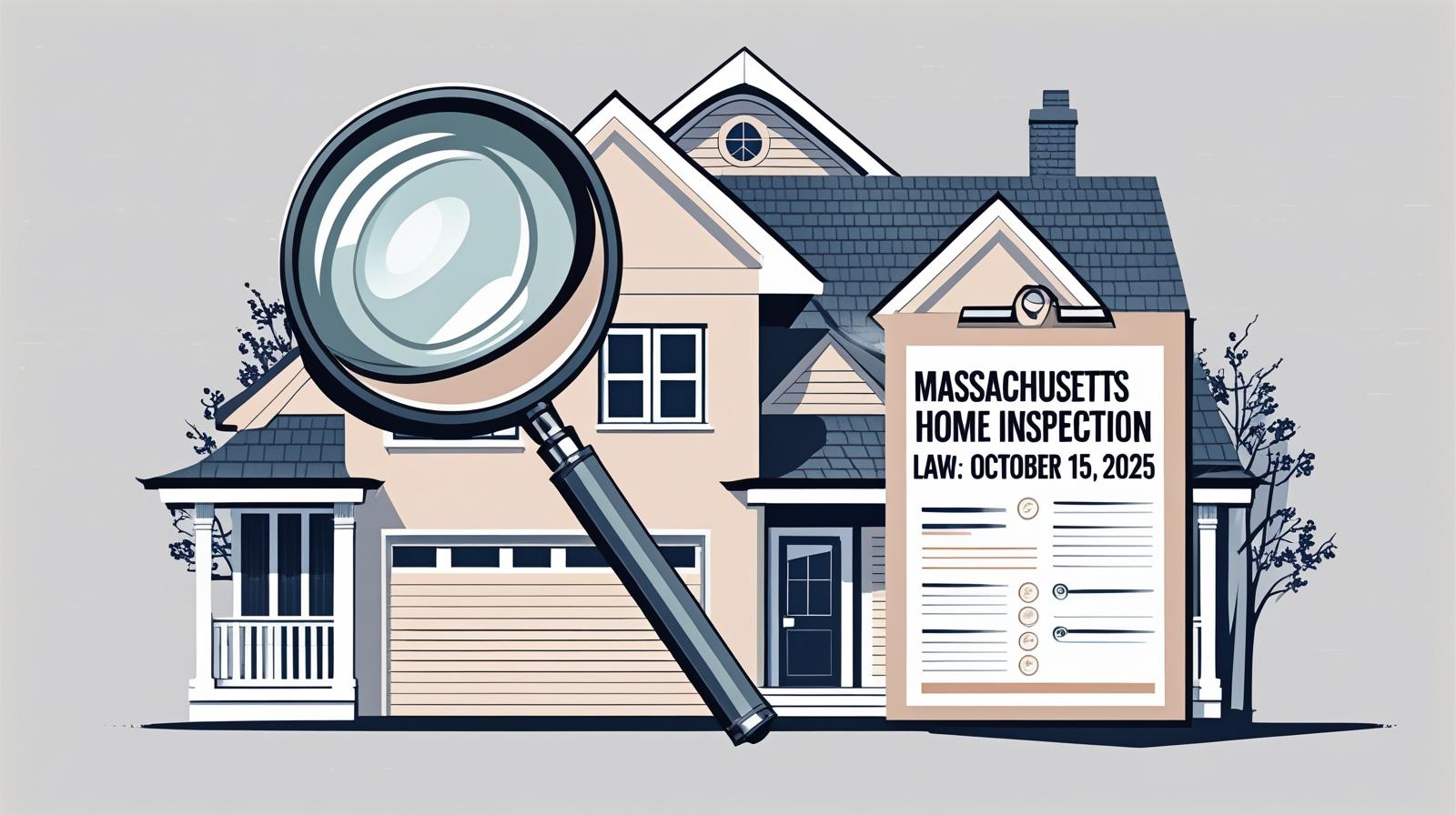
Massachusetts’ New Home Inspection Law went into Effect October 15, 2025: What You Need to Know
Buying or selling a home in Massachusetts just got a little more interesting.
Starting October 15, 2025, a new state law changes how home inspections work, and more importantly, how waiving them doesn’t.
If you’ve ever been in a bidding war, you know the pressure: “Waive the inspection and maybe they’ll pick your offer!” Well, Massachusetts has officially decided that’s not the kind of competition it wants in the housing market.
Let’s break it down minus the legal jargon and plus a little sanity.
What’s Actually Changing
Under the new rule (760 CMR 74.00), sellers and their agents can no longer make accepting an offer dependent on a buyer skipping their home inspection.
That means:
- Sellers can’t say “We’ll only take your offer if you waive inspection.”
- Sellers must provide a new disclosure form confirming buyers’ inspection rights—signed by both parties before signing an offer or purchase and sale.
- Buyers can still choose to skip an inspection, but it has to be a truly voluntary decision—not the result of pressure, suggestion, or Jedi mind tricks from the seller’s side.
- The law applies to 1–4 unit homes, condos, and co-ops.
- It’s only for contracts signed on or after October 15, 2025.
So no, home inspections aren’t mandatory, but now, neither is feeling cornered into giving one up.
Why Massachusetts Did This
Let’s face it: the past few years have been a real-estate circus. Between record-low inventory and sky-high competition, buyers have been dropping inspections faster than you can say “foundation crack.”
The state decided it was time to cool things down. Officials cited consumer protection and fairness making sure buyers get the chance to make an informed decision without sacrificing safety or sanity.
As Governor Healey’s team put it, this rule helps level the playing field. No more bidding-war brinkmanship that leaves homeowners with buyer’s remorse and a roof that leaks in five places.
What Buyers Should Know
The good news: you have more breathing room.
- You’ll receive (and sign) a disclosure form confirming your right to a home inspection.
- You still get to decide whether to inspect or not.
- Sellers can’t use “no inspection” as leverage to pick another offer.
Does that mean you should always inspect? That depends. If you’re handy, have nerves of steel, or enjoy the thrill of mystery repairs, maybe not. For everyone else, it’s usually a smart move.
Even with the new protections, it’s still worth negotiating your inspection timeline and setting clear expectations. The law allows “reasonable limits” (like capping repair requests), so communication is key.
What Sellers and Agents Need to Know
Here’s the short version: if you’re selling, update your process yesterday.
- Make sure that disclosure form is signed by both parties before any offer or P&S agreement.
- Don’t hint, imply, or outright suggest that inspection waivers make offers stronger.
- Review your templates and contingencies to ensure compliance.
- Keep everything documented. Massachusetts loves its paperwork.
This law isn’t about forcing anyone into longer closings; it’s about transparency. Think of it as adding one more checklist item to keep everyone out of hot water.
Pro tip: if you’re an agent, train your team early. Better to have an awkward “here’s the new rule” conversation now than an awkward call from the Attorney General later.
Who’s Not Affected
A few exceptions apply:
- Family-to-family sales (including estates or divorces).
- Foreclosures and similar lender transfers.
- Certain new-construction homes under warranty.
For everyone else, yes, this includes your charming three-family in Roslindale and that Cape in Westwood… the new regulation applies.
What It Means for the Local Market
If you’ve been buying or selling around Greater Boston, you know “contingency-free” offers became the norm. This new rule might shift that dynamic.
Expect:
- More buyers including inspections again.
- Slightly longer timelines (inspectors, rejoice).
- More balanced negotiations and less “take it or leave it.”
And maybe... just maybe, a few fewer stress-induced gray hairs for everyone involved.
It’s not a huge shake-up, but it does reset expectations. Sellers can still evaluate offers based on price, terms, and timing. They just can’t base it on who’s brave enough to skip an inspection.
Quick Tips for Smooth Transactions
Buyers:
✅ Make sure you sign that inspection-rights disclosure before your offer.
✅ Schedule your inspection ASAP after the offer’s accepted.
✅ If you skip it, do so by choice, not because you felt pressured.
✅ Still read the report (if you get one). Knowledge is cheaper than repairs.
Sellers:
✅ Review and sign the new disclosure form with buyers.
✅ Don’t accept offers that hinge on waiving inspections.
✅ Communicate your timeline clearly to keep things moving.
✅ Remember: transparency builds trust and trust sells homes.
Agents:
✅ Update your forms and checklists.
✅ Educate your clients (and your office) on the changes.
✅ Keep signed documentation handy for compliance.
Bottom Line
Massachusetts isn’t outlawing home-inspection waivers, it’s just removing the pressure that turned “optional” into “expected.”
The goal? A fairer process, fewer hidden surprises, and maybe a few more buyers sleeping soundly the night before closing.
Whether you’re buying in Dedham, selling in Walpole, or eyeing that colonial in Norfolk, take the time to understand the new rule and use it to your advantage.
Because at the end of the day, a house should feel like home… not like a pop quiz you didn’t study for.
Planning To Sell in 2026? Start the Prep Now

Planning To Sell in 2026? Start the Prep Now
Top Projects Massachusetts Agents Recommend Before Selling
You’ve got big plans for 2026. But what you do this year could be the difference between a smooth sale and a stressful one. If you’re thinking of selling next spring (the busiest season in real estate), the smartest move you can make is to start prepping now.
As Realtor.com says:
“If you’re aiming to sell in 2026, now is the time to start preparing, especially if you want to maximize the spring market’s higher buyer activity.”
Because the reality is, from small repairs to touch-ups and decluttering, the earlier you start, the easier it’ll be when you’re ready to list. And the better your house will look when it’s time for it to hit the market.
Why Starting Now Matters
Talk to any good agent and they’ll tell you.... you can’t afford to skip repairs in today’s market. There are more homes for sale right now than there have been in years. And since buyers have more to choose from, your house needs to look its best to stand out and get the attention it deserves.
That doesn’t mean you have to do a full-on renovation. But it does mean you’ll want to tackle some projects before you sell. Your house will sell if it’s prepped right and you don’t want to be scrambling in the spring to get the work done.
Start now, and you’ll be able to space those updates out however you want:
✅ More time.
✅ Less stress.
✅ No racing the clock.
Whether it’s fixing that leaky faucet, repainting your front door, or finally replacing your roof, you can do it right if you start now and take your time finding great contractors without paying rush fees.
Get an Agent’s Advice Early
To figure out what’s worth doing (and what’s not) in your market, talk to a local agent early. That way you’re not wasting time or money on something that won’t help your bottom line.
As Realtor.com explains:
“Respondents overwhelmingly agree that both buyers and sellers enjoy a smoother, more successful experience when they start early.”
A skilled agent can tell you:
- What buyers in your local area are looking for
- The repairs or updates you need to do before you list
- How to prioritize projects if you can’t do them all
- Which local contractors can get it done right
Having that insight early is a game changer.
What Agents Are Recommending Most
According to the National Association of Realtors (NAR), here are the top projects agents recommend before selling:
Top Projects Agents Recommend Before Selling
- Paint the Entire Home – 50%
- Paint an Interior Room – 41%
- Replace the Roof – 37%
- Upgrade the Kitchen – 30%
- Renovate the Bathroom – 24%
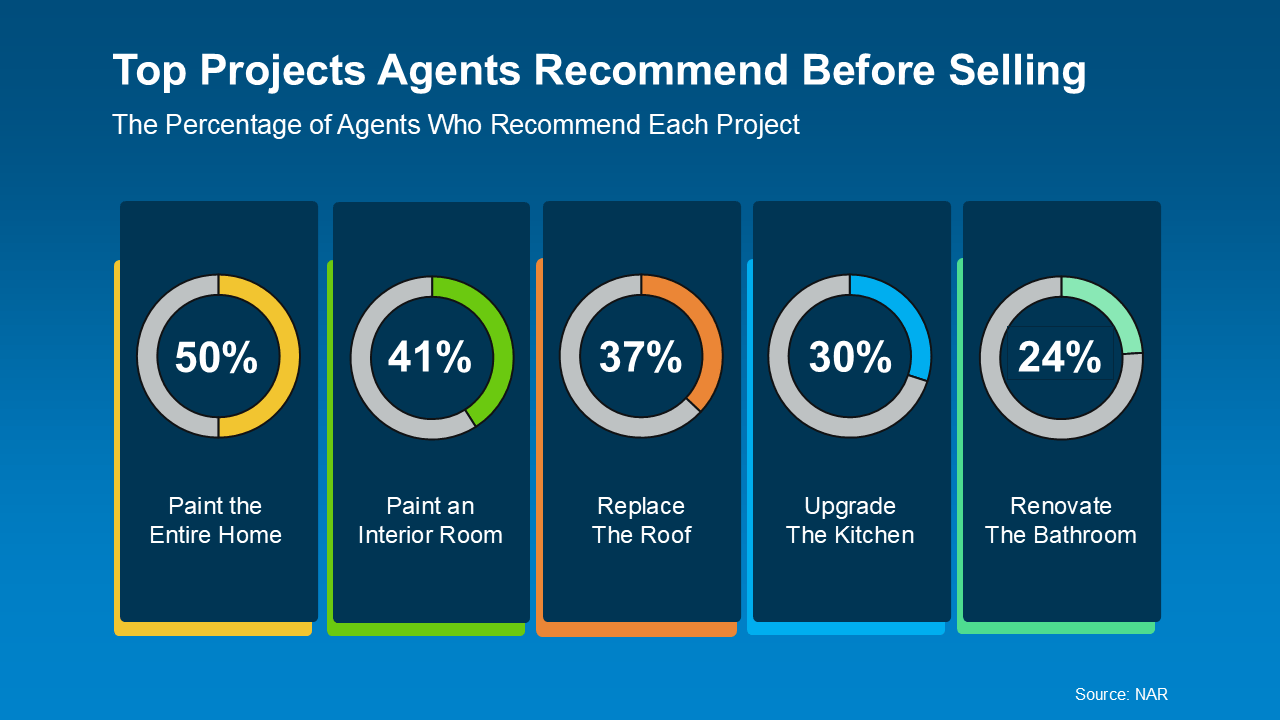
Image credit: NAR
Keep in mind, what’s worth updating depends on your specific market. Some homes only need light refreshes; others may need a few bigger updates to compete.
Bottom Line
If your plan is to sell in 2026, it’s time to get serious. Taking some time to prep means you’ll hit the market confident, ready, and ahead of other sellers who waited until January to start.
Want to know which projects are getting the best return in Walpole, West Roxbury, Dedham, or your neighborhood? Let’s connect so you can head into next spring with a solid game plan.
Why October Is the Best Time To Buy a Home in 2025 (Especially Around Boston’s Suburbs)

Why October Is the Best Time To Buy a Home in 2025 (Especially Around Boston’s Suburbs)
The Fall Advantage: Why October 2025 Is the Month to Make Your Move
If you’ve been sitting on the sidelines waiting for the “right time” to buy — grab your pumpkin spice latte, because that time is now.
According to Realtor.com, October 2025 is shaping up to be the most buyer-friendly month of the year, with a rare combination of factors tipping the scale in favor of homebuyers.
“By mid-October, buyers across much of the country may finally find the combination of inventory, pricing, and negotiating power they’ve been waiting for—a rare opportunity in a market that has been tight for most of the past decade.” — Realtor.com
What Makes October a “Sweet Spot” for Buyers
It’s not just a feeling — it’s backed by data. This month tends to bring:
- More homes to choose from — Inventory usually peaks as sellers who listed in summer are still on the market, joined by fresh fall listings.
- Less competition — Many buyers tap out once school starts or the holidays approach.
- Better prices — Homes that have been sitting since summer are often reduced to attract fall buyers.
- Sellers more willing to negotiate — If a home hasn’t sold yet, sellers become more flexible on price and closing terms.
- More time to browse — With fewer bidding wars, you can actually take a breath before making a decision.
What That Means for Boston Suburb Buyers
While the national “Best Week to Buy” lands around October 12–18, our local market in Greater Boston — especially in Walpole, Westwood, Dedham, Roslindale, and West Roxbury — tends to hit its stride a little later in the month.
In fact, Boston-Cambridge-Newton is projected to see its “best week to buy” between October 26 – November 1 this year. That means buyers in nearby suburbs could have prime conditions through Halloween and into early November.
If you’ve been struggling to find something in your price range all summer, the next few weeks could finally bring relief.
Why Fall Buying Feels Different
Let’s be honest — buying a home in spring can feel like standing in line at a Taylor Swift concert. Everyone wants in, everyone’s bidding high, and emotions run hot.
Fall? Much calmer.
Here’s what local agents (myself included!) love about helping clients buy in October:
- Sellers are serious. They’re not “testing the market” — they want to move before winter.
- Homes show beautifully. Crisp air, cozy lighting, and fall curb appeal make it easier to envision your new home.
- Local service providers have more availability. Need inspections, movers, or painters? You’ll wait less and likely pay less.
What the Experts Are Saying
It’s not just us real estate folks in Massachusetts who see the shift — the national experts agree:
“Homebuyers are in the best position in more than five years to find the right home and negotiate for a better price. Current inventory is at its highest since May 2020.”
— Lawrence Yun, Chief Economist, National Association of Realtors
“Now is a good time to buy, if you can afford it . . . with falling mortgage rates and significantly more inventory, buyers have an upper hand in negotiations.”
— Daryl Fairweather, Chief Economist, Redfin
“This fall just might be the best window for home buyers in the past five years.”
— NerdWallet
Local Snapshot: What’s Happening in Norfolk County
Here’s what we’re seeing locally as of early October:
- Inventory has ticked up, especially in Walpole, Norwood, and Westwood, giving buyers more to choose from.
- Days on Market are increasing slightly, meaning sellers are open to offers and discussions.
- Price reductions are happening — not across the board, but selectively where homes were priced too aggressively in summer.
- Interest rates have eased from their midyear peak, giving buyers a little more breathing room on monthly payments.
All this adds up to opportunity — but timing still matters.
How To Prepare for This “Golden Window”
If you’re ready to buy this fall, here’s your October playbook:
- Get pre-approved immediately. You’ll move faster when the right home hits the market.
- Know your local market. Every town — Walpole, Dedham, Norfolk, or Westwood — behaves a little differently. Work with an agent who can interpret those micro-trends.
- Watch for price drops. Properties that have lingered since July or August often adjust pricing right now.
- Schedule showings quickly. While competition is lower, good homes still go fast.
- Negotiate smartly. You may now have room for closing cost credits or flexible closing dates — things we rarely saw last year.
Bottom Line
If you’ve been waiting for the right moment to make your move, October 2025 is your month — especially across the Boston suburbs.
With inventory up, competition down, and sellers eager to deal before the holidays, this is the best balance of opportunity buyers have seen in years.
Let’s get your strategy in place now so you can take advantage of this narrow, powerful window.
Schedule your homebuying consultation today or get a free home search setup customized to your favorite towns.
How to Downsize Smartly in Boston’s Suburbs Without Sacrificing Lifestyle

How to Downsize Smartly in Boston’s Suburbs Without Sacrificing Lifestyle
You’ve raised your family, filled every bedroom, every closet, and maybe even the garage (or two). Now the kids are grown, the house feels too big, and you’re ready for the next chapter. But here’s the million-dollar question: how do you downsize smartly in Boston’s suburbs—think Westwood, Walpole, Roslindale, Dedham, Norfolk, Wrentham—without feeling like you’re giving up the lifestyle you love?
Spoiler alert: downsizing doesn’t mean downgrading. Done right, it can mean less maintenance, more freedom, and a home that suits this new phase of your life beautifully. Let’s dive in.
Why Downsizing Makes Sense
Empty nesters often reach a turning point where the family home feels more like a museum of memories than a practical living space.
- Too much house to clean (and we all know dust multiplies faster in empty rooms).
- High utility bills for heating and cooling unused space.
- Lawn care headaches—those shrubs don’t prune themselves.
- Equity locked in your current home that could fund your retirement, travel plans, or even that dream beach cottage.
In towns like Westwood or Walpole, where home values have soared, selling a larger home can free up equity while letting you stay close to family, friends, and all the Boston-area amenities you love.
Suburbs That Are Perfect for the Next Chapter
If you’re thinking of downsizing but staying local, here’s what’s attractive about some popular nearby towns:
- Westwood: Known for excellent schools (still a selling point for buyers) and proximity to Route 128, but also offers luxury condos and smaller homes with walkability.
- Walpole: A mix of classic colonials and newer townhome developments, plus the charm of Bird Park and the convenience of Walpole Center.
- Dedham: Legacy Place for shopping and dining, plus historic charm and commuter rail options.
- Norfolk: A quieter, more rural feel, but with commuter rail access straight into Boston.
- Wrentham: A balance of small-town living with outlets, dining, and plenty of recreational space.
Smart Downsizing Tips
Here’s where the rubber meets the road—or in Boston’s case, where Route 1 traffic meets the backroads shortcut.
1. Start with Your Lifestyle Goals
Ask yourself: Do you want to travel more? Be within walking distance of coffee shops and community centers? Have space for grandkids to visit? Your new home should match your vision for the next decade, not just the next move.
2. Think “Right-Sizing,” Not Just Downsizing
Smaller doesn’t mean sacrificing. Look for homes that are:
- Single-level living (bye-bye stairs).
- Open floor plans for entertaining without the square footage.
- Low-maintenance exteriors like vinyl siding or condo associations that handle landscaping.
3. Purge Before You Pack
Easier said than done, but this is key. Sort items into:
- Keep (things you truly love or use daily).
- Donate (local charities in Walpole, West Roxbury, and Dedham are always grateful).
- Sell (estate sales or even Facebook Marketplace work wonders).
- Toss (no one needs that VCR anymore).
4. Consider New Construction & 55+ Communities
Many towns around Boston have seen a boom in townhomes and active adult communities. They often offer:
- Clubhouses and social activities.
- Maintenance-free living.
- Modern finishes without renovation headaches.
5. Don’t Forget Location, Location, Location
You may be giving up square footage, but make sure you’re gaining convenience. Proximity to:
- Grocery stores (Walpole Stop & Shop, Dedham Whole Foods).
- Healthcare (Newton-Wellesley, Norwood Hospital - Yah, I know. It’s coming).
- Public transit (commuter rail lines from Westwood, Norfolk, or Walpole).
Common Downsizing Mistakes to Avoid
- Waiting too long—moving is easier when you’re still mobile and energetic.
- Keeping too much stuff—your new space will thank you if you edit now.
- Focusing only on cost savings—yes, a smaller home may be cheaper, but also make sure it adds to your quality of life.
- Overlooking resale value—choose a property that will be desirable if you need to sell again.
Downsizing Checklist
Here’s a quick cheat sheet for Boston-area downsizing:
✅ Evaluate current and future needs (mobility, family visits, travel).
✅ Choose a town that fits your lifestyle (walkable vs. quiet retreat).
✅ Explore 55+ or new construction options nearby.
✅ Purge ruthlessly—less is truly more.
✅ Lean on a local REALTOR® who knows the suburban market (hi, that’s me 👋).
Helpful Resources
- Bird Park, Walpole – a community favorite for walking and events.
- Legacy Place, Dedham – dining, shopping, and entertainment at your doorstep.
- Wrentham Village Premium Outlets – because downsizing doesn’t mean cutting back on shopping.
Final Thoughts
Downsizing in Boston’s suburbs doesn’t have to mean giving up the lifestyle you love. In fact, it can mean simplifying your home while expanding your experiences. With the right plan, you can trade in lawn mowers and unused bedrooms for coffee dates, weekend trips, and a home that finally fits just right.
Ready to explore your downsizing options? Get your free home valuation today and start your next chapter with confidence.

 Facebook
Facebook
 X
X
 Pinterest
Pinterest
 Copy Link
Copy Link

